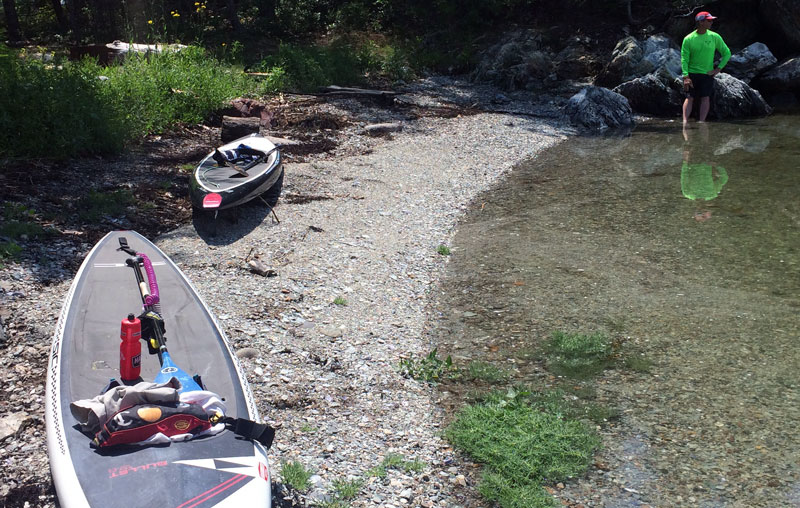Lots of people ask about the supplements I use, but Hammer Nutrition wouldn’t keep me on as a sponsored athlete—and I wouldn’t have such success in the Snipe—without a solid fitness program. So I thought I’d share five tips that deliver benefits, year after year and season after season, in hopes that they might also help others develop a lifelong approach to fitness.

Tip #1: Find something you enjoy
Over the years, I’ve realized that nothing keeps me fitter than something I really enjoy doing. Since 2012, I’ve been standup paddling (SUP) 2-4 days a week, year-round. It gets me out on the water, provides an excellent (almost) full-body workout, and offers a surprising amount of variety (everything from yoga to wave-riding). In summer, I follow up each morning paddle with a quick swim, and when I’m really pushing hard I supplement that with a few pushups and situps right on the board. My own little triathlon, all without leaving the harbor!
Tip #2: Do something (almost) every day
Working out 5-6 days a week makes it easier to form the habit, even if it’s at a lower intensity on some of those days. Just as those “still-able-to-talk” walks are surprisingly beneficial, even a quick stretch on a day without much spare time is better than staying in bed (or staying up for a second cocktail). Don’t forget to take a day off at least once a week, and make it a special treat.
Tip #3: Have a goal
Situps for situps’ sake are not a powerful motivator. But an upcoming world championship, at a windy venue? That keeps me pushing hard right through the third set. Even if your goal is to walk up the stairs without pausing, it’s important to have something you can focus on besides the actual reps.
Tip #4: Find a partner
I’m lucky enough to share a home gym and a passion for being on the water with my husband, Paul. He is even more motivated than I am to work out every day, and he’s also better at searching out new techniques and equipment that help keep our workouts fresh. Though I fell in love with standup paddling before he did, he’s the one who researched what are now our favorite boards and paddles. If your life partner doesn’t provide this kind of motivation, either find a friend, commit to a regular class at the local gym or yoga studio, or hire a trainer who fits your budget and goals. Nobody can stay motivated on their own.

Tip #5: Change it up
No matter how motivated you are, doing the same routine week after week and year after year gets boring. Here in New England, the weather dictates a change in priorities every few months: more yoga and gym workouts in the winter, more paddling and swimming in the summer. If you’re lucky enough to live in a year-round climate, changing your workouts every month or two is the only way to stay with it in the long term—which is all that really matters. (For a specific example, read SUP Yoga: Crosstraining to a New Perspective.)
It’s also important to vary intensity throughout the year. Identifying “A” goals (like that windy world championship) will help pinpoint when to peak—and make the after-lull even better. Lulls don’t mean becoming a couch potato, though, because more than three days off in a row will make it much harder to get back to your routine. Keep the frequency high, but back off the intensity level—until it’s time to work toward the next peak goal.
Growing older, staying fit
Fitness ebbs faster than it flows, and that unfair truth only seems to become more true with age. That’s why it’s important to do something every day—and the key to doing that is to enjoy the process. Find a workout you enjoy, do it most days, and you too will find yourself reaping lifelong benefits.
How about you? What’s your key to getting and staying fit? Join the conversation below, or send me an email. Your notes are part of what keeps me motivated, and I read every single one.
I love our paddle adventures, if it is a downwinder, or paddling around the ice in the winter.
Me too!
Carol, great guidance. Staying fit is tremendously beneficial in multiple ways. It enables one to enjoy numerous other activities with a base level of fitness. It clears the mind and makes daily tasks easier.
My rules of thumb follow yours. In addition:
– Don’t try to replicate what you did when you were 18. Be proud of what you can do today and realize that your times from 30 years ago are great memories, and they will remain memories. Otherwise you’ll break yourself.
– Set basic goals which require effort but are achievable.
– Variation as Carol states, w/in a routine, keep you fresh
– Find a masters swim team, triathlon team, cycling team, running/walking group – socializing helps pass the time and increase the enjoyment
– If sailing is your primary sport, just about any fitness activity will help. Strength training is super helpful.
Thanks Hal, this is a great addition to the 5 tips.
Loved this! A light run, rarely more than two miles, (almost) every morning coupled with strength training and yoga is my ticket at 54. I used to have to drag myself out the door at 6am but now it’s just routine and to miss it feels like forgetting to brush your teeth. Decide and do and don’t look back!
Jill, agreed that “missing” a routine is like not brushing teeth! Thanks for your thoughts, and keep up the good habits.
Thanks all for the great comments. In addition to those posted here, there’s been a great discussion (and reminders for additions) on the Facebook post. Here are the highlights, in the order received; to read them all, see https://www.facebook.com/carol.n.cronin/posts/10157465529713749?notif_id=1568289830176509¬if_t=feedback_reaction_generic
Alex Pline
Here’s one you missed: #6 – Work tips 1-5 into your daily life so it “just happens” as a matter of course rather than something extra that eventually ends up being a chore. That’s why new years resolutions to go to the gym never last (and gyms bank on that) because people get busy and that “extra” thing is the first to drop from the to do list. Sure #6 takes some extra work in the beginning, but once a habit is established, it lasts. Examples: walking and biking short distances instead of driving; taking stairs instead of the elevator; stretch at your desk, etc.
Merritt Keffer
Use your kids sports practice time as your workout time. While they are playing soccer you can walk/run etc.
Nikki Bruno
I think remembering to rest, breathe properly, and also nutrition/hydration is key too. Especially if your body isn’t used to working out to a new extent. Case in point: I forgot how much more often I need to eat when I’m back in a weightlifting routine, ate breakfast but didn’t have a pre-gym snack yesterday, and kept having to take breaks because I was getting lightheaded lol
Kim Couranz
Cardio intervals. With a heart rate monitor. Push it high; keep it high. It’s nice to go aerobic for a nice amble, but to really expand fitness, go high intensity, let your heart rate recover, push it high again, recover, repeat…a bunch of times, interval style. If no heart rate monitor to ensure you’re getting to anaerobic/threshold levels, get seriously breathless during intervals.
Alex Pline replies: Kim yes they are super important and people often don’t want to do them because, as you know, they are not pleasant, but that’s what it takes.
I have friends who have kept a calendar to record their sailing days for decades but never subscribed to that method until this year. Now I’m driven to get on the bike or go wavesailing (or even trail run in the worst of weather) every possible day to fill each month. I’m still a bit baffled by how simply logging days could force this behavior but love the result!
Paul keeps track of his sailing days too. I’ve tried a few times but never seem to stick with it. So great it’s become another motivator for you!
Very good summary. I always say that consistency is the key. And yes – add some variations to your routine – this is something I could not agree more to.
Thanks Sebastian!
Variety is important. I sail a Star and ski. For me (haha, as a cardiologist) I start with the cardio base…and if I don’t have time for weights, go back to the cardio. Cardio for me, ever since getting a stress fracture back in the day, and a partial ACL tear decades ago, is using the Concept II rowing ergometer. 5K meters on setting 8 at a split of about 2:10-2:15/500. Low impact and works legs, shoulders, back, and core. It’s my understanding that the UK sailing folks rely on this, especially the Finnsters, who free pump (https://www.rya.org.uk/SiteCollectionDocuments/Racing/Web%20Documents/Concept2_sailing_guide.pdf0.
My alternative cardio on weekends, if not sailing or sking, is hiking up a steep pitch at Sleeping Giant State Park, north of New Haven, with the goal of passing the youngsters, which I almost always am able to do. The strength training, maybe 2-3 times a week (should be more) is leg machines, flexion/extension, and lifting barbells for arms, and cable weights for shoulders (rotator cuff jazz). The key thing as you point out, is just show up, if you don’t have a lot of time.
Jim, thanks for the great input from a guy who’s practicing what he preaches!
typo. https://www.rya.org.uk/SiteCollectionDocuments/Racing/Web%20Documents/Concept2_sailing_guide.pdf